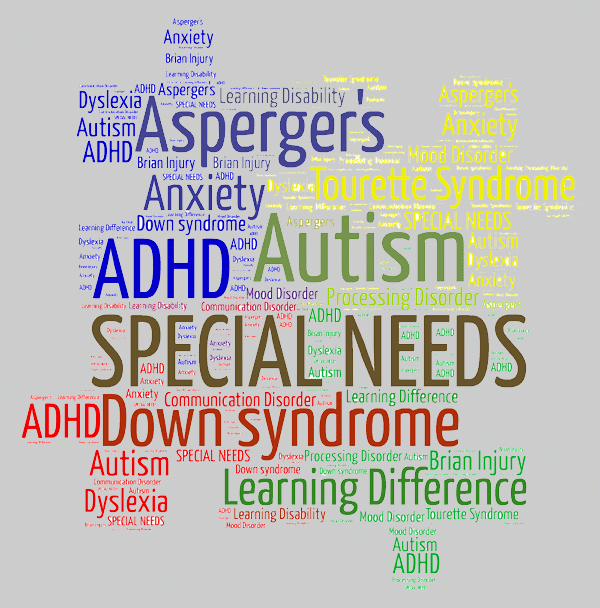Parenting and Coping Tips for You and Your Special Needs Child
Table of Contents
Parenting a child with special needs come with unique challenges, but one of the most difficult challenges for parents is dealing with meltdowns. For children with autism, Asperger’s, down’s syndrome, and other special needs, meltdowns that include aggressive behavior are fairly common, and they’re often scary, dangerous, and emotionally devastating for parents.
As a step-mom to a son with down’s syndrome, I didn’t come into his life until he was 13 years old, and the very first time I witnessed a meltdown was terrifying. In a moment, my sweet, loving son was transformed into a child who was screaming, hitting, kicking, and banging his head. It took his father and I both to keep him from hurting himself, and when it was over, it was like a switch had been turned off and he was back to himself.
For several years, the meltdowns were rare, occurring only every few months. But after his father died, the meltdowns escalated until he was having them multiple times per week, and I was getting hurt. My son was strong enough to throw me, and his meltdowns were getting increasingly dangerous for both of us.
The feeling of having your child, that child you love so fiercely, scream at you and hurt you is indescribable, and it’s tough to work through the emotions that come with dealing with those meltdowns. The key to surviving meltdowns with your special needs child is to learn effective tactics for dealing with them, how to prevent them, and how to cope with them yourself.
Understanding the Difference Between Tantrums and Meltdowns
Many parents confuse a meltdown with a tantrum, and the two are very different and must be handled differently. Just like any other child, special needs children often have tantrums when they don’t get their way. However, if you pay attention, it’s easy to learn the difference between a tantrum and a meltdown.
- During meltdowns, special needs kids don’t care how other people are reacting, while kids having a tantrum will try to see if they’re getting a reaction with their behavior.
- A child having a meltdown doesn’t consider the safety of himself or anyone else, while a child having a tantrum will ensure he doesn’t get hurt.
- Tantrums end quickly if the situation is resolved, while meltdowns often continue at their own pace and wind down over time.
- A child is out of control when having a meltdown – they can’t calm down and are no longer in control of the situation. But when a child is throwing a tantrum, you’ll get the feeling that they are in control of their behavior.
- Tantrums often occur when a child doesn’t get his way and can usually be quickly and easily managed with discipline and intervention from the parent. On the other hand, a meltdown takes place when a child cannot manage their emotions and the sensations that come with them, resulting in an inability to calm down because they unable to form cohesive thoughts so they can ask a parent or caregiver for help.
Tips for Dealing with a Meltdown
When a meltdown occurs, you’re going to have to ride out the storm. It can take time to get a special needs child to a place where he can start calming down enough to manage the internal and external stimulation that comes with a meltdown. The main goal – make sure that you, your child, and other individuals stay safe.
Remove Other Children from the Room
If you have other children, remove them from the room immediately if your child has a meltdown. It’s not only important for their safety, but it will also ensure that your other children don’t add additional stimulation to the environment, making the meltdown worse. This is especially important if you have young children. Train your children to leave the room when a meltdown occurs at your command.
Remove the Child from Danger
When a meltdown occurs, make sure your child is well aware from dangerous objects or areas, such as glass shelving, glass objects, sharp objects, or walls. Keep them away from objects they can throw at people. Your main priority is to avoid injury when a meltdown occurs.
Don’t Try Reasoning with Your Child
Most kids don’t have the ability to listen during a meltdown, so don’t try to reason with your special needs child. Excessive talking can actually add to the sensory overload, making the problem worse.
Find Distractions for Your Child
Distracting your child or diverting their attention often helps to diffuse the situation. Since sensory overload is often the cause of a meltdown, distract your child with a calming sensory input. If lights cause sensory overload, try sunglasses. If sounds are overwhelming your child, is worth to consider soundproof headphones. Chewy snacks, a squeeze ball or play-doh, washing their hands in warm water, rubbing a soft piece of fabric, or jumping on a mini trampoline may prove distracting.
You may also want to consider the way your child’s aggression comes out during a meltdown when coming up with distractions for your child. Silly putty or play-doh are great for kids that hit, since it keeps their hands busy. Jumping on a trampoline or a comforting foot massager may be perfect for a child who kicks.
Stay Calm and Speak Softly
A child having a meltdown is already experiencing sensory overload, so it’s extremely important to stay calm and speak softly. When your child is screaming, kicking, and hitting, it’s difficult to stay calm. It’s easy to allow the fight or flight response to kick in, responding with yelling of your own, but you have to stay in control. Keep your voice soft and non-threatening as you work to help your child regain control.
Learn a Proper Hold to Deal with Physical Aggression
If your child hits, bites, scratches, kicks, or beats his head during a meltdown, you must learn a proper hold to deal with physical aggression safely. When possible, let your child calm down without intervening physically, but if he becomes a danger to you, himself, or others, you must help him calm down in a safe way.
The best way to accomplish this is to gather your child in your arms while facing him away from your body. Get his back to your stomach and wrap him in a hug. If you’re smaller or you have a larger child, you may need to wrap both your arms and legs around him to keep him secure. When your child is flailing around, you’ll be better able to keep him from kicking you, hitting you, or scratching at your face. This hold reduces the risk of leaving your child with red marks or bruises as well.
Preventing Meltdowns Before They Happen
It’s not always possible to prevent meltdowns, and if you can’t prevent a meltdown, you shouldn’t feel like you’ve failed as a parent. However, learning a few meltdown prevention strategies can help reduce the number of meltdowns you’re dealing with, which is great for you and your child.
Try to Figure Out What’s Triggering the Meltdowns
Identifying what’s triggering your child’s meltdowns is one of the best ways to prevent future meltdowns. When you’re aware of your child’s triggers, you can work to diffuse the problem before it turns into a full-scale meltdown.
Triggers vary from child to child. Many special needs children have meltdowns in response to sensory overload. Kids can be affected by lights, smells, textures, or noise. Too much input can leave a child with special needs struggling to cope, resulting in a meltdown.
Social challenges, particularly for kids on the autism spectrum, may cause meltdowns. Social encounters can be overwhelming for these children, resulting in social confusion and stress that takes its toll throughout the day until a meltdown occurs. You can look into an Autism Spectrum Disorder Treatment Plan so you could address his needs and it might lessen his tantrums and meltdowns.
Long term stress, such as the stress that comes with grief, may result in meltdowns. Stress is even more likely to cause a meltdown in a child who is unable to communicate the emotions he feels as a result of a stressful situation.
For some special needs children, diet can trigger meltdowns. Sugar and carbs, or even gluten, are known to result in increased anxiety in children, particularly those on the autism spectrum.
How do you identify your child’s triggers? Try keeping a journal of your child’s meltdowns. Each time a meltdown occurs, log the following:
- When the meltdown occurred
- What took place right before the meltdown
- The result of the meltdown
- What your child had to eat that day
- How much your child slept the night before
- What the weather was like
Over time, it’s often possible to identify patterns of behavior, helping you figure out what may be triggering the meltdowns so you can better prevent and diffuse them in the future.
Be Aware of Your Own Emotional State
Children with special needs are very good at tuning in to their parents’ emotional state, and your emotional state can affect your child. Learning to control your own emotions can help prevent meltdowns in your child. Learn to reduce your own stress levels, avoid rushing around anxiously to deal with time constraints, and never take your emotions out on your child.
Try Sticking to Daily Routines
Many children with special needs rely on their routine. Routine makes them feel comfortable, and many kids depend on their routine because too much change can feel overwhelming. Changes in daily routines can easily set off your child, so try sticking to your daily routine as much as possible. When you have to deviate from a normal routine, ensure your child is feeling content and well rested.
Consider Behavioral Therapy
When meltdowns become particularly common or violent, it’s time to consider some outside help. Personally, turning to behavioral therapy left me feeling like I was a failure as a parent, but it was one of the best things I could have done for my son. A good behavioral therapist can help analyze the situation and since they are emotionally removed from the situation, they are often able to see trends and triggers that you cannot. Working together with a behavioral therapist can help you come up with positive solutions for meltdowns and other behavioral issues, finding ways to reduce meltdown occurrence and severity.
Coping Tips for Parents
Dealing with meltdowns can take a toll on parents, both physically and emotionally. Not only do you need to be armed with tips to get your child through a meltdown, you also need to learn how to cope with them yourself.
Don’t Take the Meltdowns Personally
When you’re the one dealing with kicking, punching, biting, head butting, and glass-shattering screaming, it’s easy to feel like your child’s meltdown is a personal assault. As the parent, you’re tasked with trying to minimize property damage and keeping others, yourself, and your child safe. It’s a challenge to keep your composure when your child has no ability to stay in control of their own behavior.
While you’re the one dealing with the brunt of a meltdown, realize that it’s not personal – you’re simply the closest target. Your child has lost all control of the situation; he’s not lashing out at you. It feels devastating to have a child you love hurting you, and it’s tough to keep from taking it personally. But you must remember that the anger and aggression isn’t about you, it’s about your child’s inability to cope with the situation.
Remember the Meltdown Will End
Meltdowns will end. Your child’s energy will run out. They’re exhausting for your child and for you. Realizing that the meltdown will end can help keep you steady throughout the meltdown so you can regain the control your child has already lost. If it happens in public, it’s embarrassing, but learn to ignore what others have to say and hold on to the fact that it will end.
Get Some Emotional Distance
It’s so easy to be sucked into the emotional and psychological vortex of a meltdown, but try getting some emotional distance by getting your mind into a quiet, restful place that allows you to become detached from the meltdown. You also need to learn to distance yourself from insensitive, thoughtless comments that come from friends, family, and even complete strangers.
Take Care of Yourself
You are the first and last defense for your child with special needs, and most of the time, you’ll be the one trying to get your child through a meltdown. To do this effectively, you must take care of yourself – a lesson I’ve learned the hard way. It’s easy to focus all your time and attention on your child’s welfare, but when you fail to take care of yourself, you won’t be equipped to offer your child the best possible care.
Meltdowns are one of the toughest parts of being a special needs parent. I’ve spent more times than I can count locked in the bathroom crying and hurt after going through a meltdown with my son. And it’s okay to walk away and fall apart after a meltdown. Just remember, you’re not alone and you will get through this. Turn to other special needs parents and loved ones for support and help. Find someone to talk to so you have a place to put your emotions instead of turning them back towards your child.
These days, meltdowns are rare. In fact, my son has gone for more than three months without a single meltdown. I’ll be honest, there were days I thought I’d lose my mind if I had to go through one more meltdown, but I survived, and so did my son. Will he have more meltdowns in the future? Probably. But I’ve learned an important lesson – this too shall pass. We’ve been through some dark times together, but we made it, and when the next meltdown occurs, we’ll make it through that one too, because I’m determined to love him through every meltdown. After all, that’s what parents do.
Biography












21 Comments